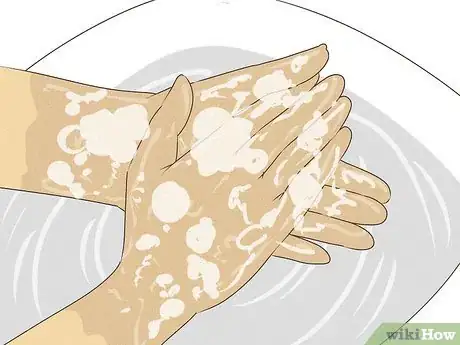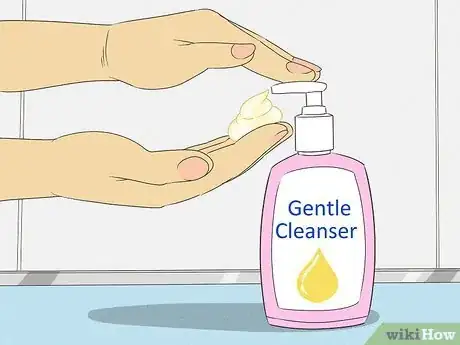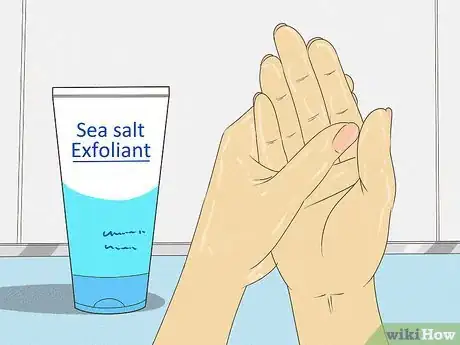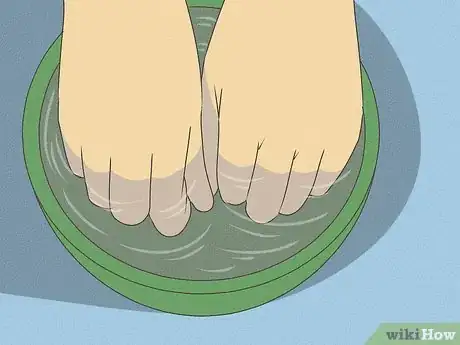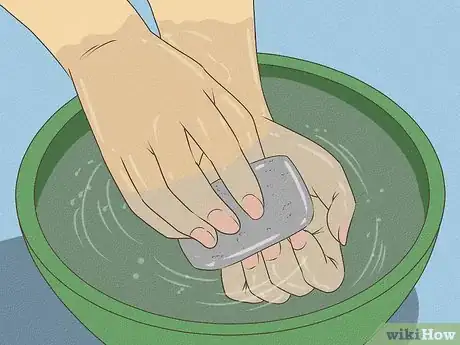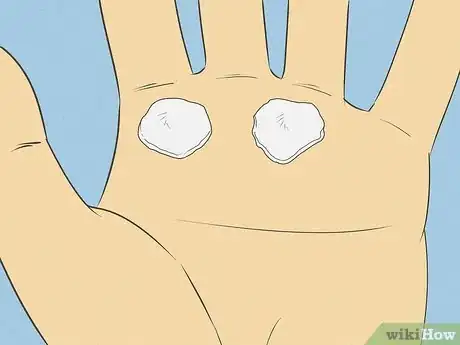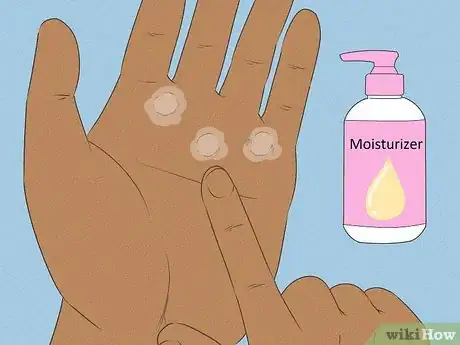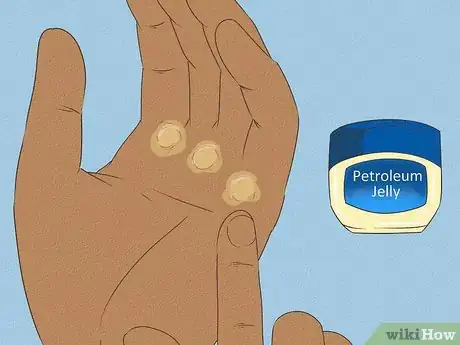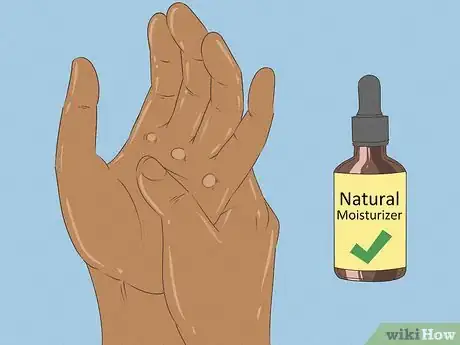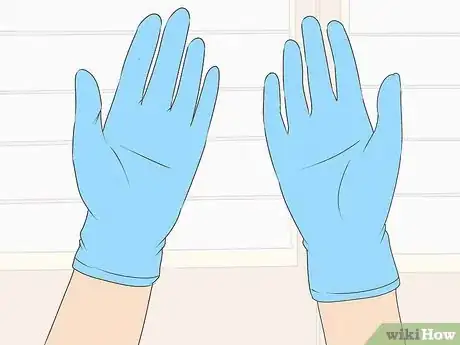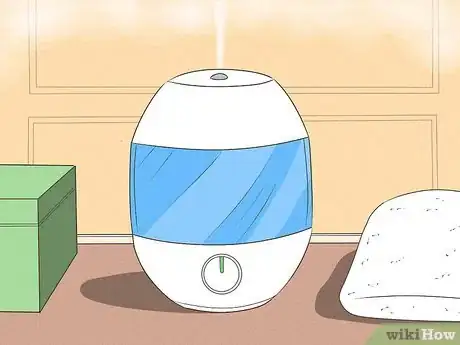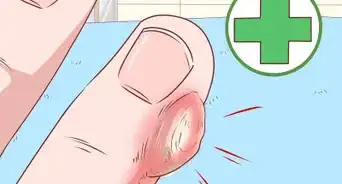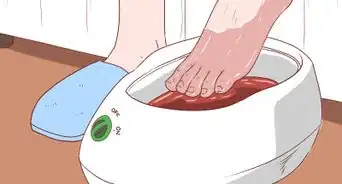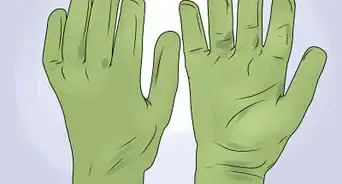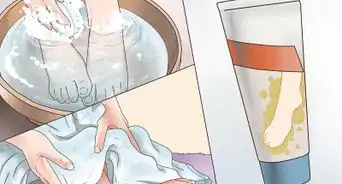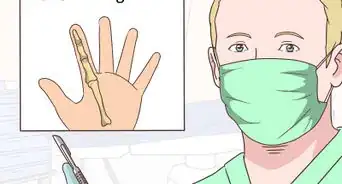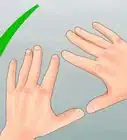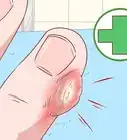This article was medically reviewed by Troy A. Miles, MD. Dr. Miles is an Orthopedic Surgeon specializing in Adult Joint Reconstruction in California. He received his MD from the Albert Einstein College of Medicine in 2010, followed by a residency at the Oregon Health & Science University and fellowship at the University of California, Davis. He is a Diplomat of the American Board of Orthopaedic Surgery and is a member of the American Association of Hip and Knee Surgeons, American Orthopaedic Association, American Association of Orthopaedic Surgery, and the North Pacific Orthopaedic Society.
This article has been viewed 55,806 times.
You use your hands all the time, so it can be hard to ignore cracked and callused hands. Your environment, the season, hand-washing, chemicals and hard work can all take a toll on your hands. Rough hands can be abrasive, painful and unattractive. You probably want to restore your hands so they are soft and smooth again.
Steps
Caring For Your Hands
-
1Wash your hands. Even chronically dry hands must be washed to avoid contagious viruses and bacteria. Use warm water because hot water can strip skin of its protective oils. Be gentle when you wash your hands and pat your hands dry instead of rubbing them with a towel.[1]
- If you have a job that requires frequent hand-washing (12 or more times a day) or your hands are severely dry, then you may want to consider hand-sanitizer or wipes some of the time. Though they can also be drying, they tend to be gentler than washing that frequently with soap and water.[2]
-
2Use a gentle cleanser. Get moisturizing or hypoallergenic soap. Don’t use antibacterial, alcohol-based toners, products with alpha-hydroxy acids or heavily-scented soap. Additives and chemicals in these kinds of soap can irritate the skin and strip the oil that helps keep your skin moisturized.Advertisement
-
3Use an exfoliant. You can purchase a body exfoliant or one meant for your hands—a sea salt exfoliant is highly recommended. Use the exfoliant once a week to scrub off dead skin and keep the skin from thickening. Remember to be gentle on your hands, especially if they easily become dry and cracked.
- You can also make a scrub for your hands. One way is to grind about 1 cup of uncooked oats into a fine powder and rub the skin of your hands with the powder.
- Make a sugar-lime paste by combining sugar and lime juice until you get the consistency of an exfoliant or paste. Massage the mixture into your skin. Leave it on for about a minute and rinse. The sugar exfoliates the skin on your hands while the lime juice evens skin tone.
-
4Soak your hands. Get a bowl of warm water and place your hands in the water. Soak them for 5 minutes but not much longer or you may dry them out more. Pat them dry.
- You can add soda bicarbonate (baking soda) in your bowl of warm water and soak your hands for up to 10 minutes.
- You may also choose to add oils to your water, such as olive, argon or essential oils to help soften thick skin.
- Always rinse your hands after soaking to help remove dead skin cells.
-
5Get rid of thick skin. While bathing or soaking your hands, use a nail file, emery board, wash cloth or pumice stone to scrub the thick areas on your hands. This can help get rid of the thicker skin and callouses. Make sure your hands are moist when you rub them and to avoid infection, don’t be too rough or use any sharp objects.
- If you are diabetic, always consult with your doctor before doing anything that could cause damage to your skin because people with diabetes have a higher risk of developing infections. Don't use a pumice stone either.[3]
- If you need further treatment on your thick skin, ask your doctor. He or she can use a scalpel or trim thick skin at an office visit. The doctor can also prescribe a medication or callus-removing patch with a chemical, such as salicylic acid, that you apply to your skin.
-
6Try a non-prescription pad. You can use a pad to cover the thickened area and protect it from friction. Some of them may also contain salicylic acid to help get rid of calluses. Be cautious when using these because they can cause skin irritation.
Moisturizing
-
1Choose a moisturizer. Moisturizing your skin is essential for treating cracked and callused hands. You will want oil-based, alcohol-free emollients and humectants that will lock in moisture like ointments and creams. Avoid water-based moisturizers which aren’t very effective, such as lotions.
- Emollients are basically skin lubricants that feel slippery, soften skin and help make it smooth and pliable. Emollients might contain lanolin, mineral oil, jojoba oil, isopropyl palmitate, propylene glycol linoleate, squalene or glycerol stearate as an effective ingredient.
- Humectants use the moisture in the air around you to increase your skin’s water content. Effective humectants include glycerin, hyaluronic acid, sorbitol, propylene glycerol, dimethicone, urea or lactic acid.
-
2Moisturize regularly. Every time you wash your hands, use a moisturizer, preferably while your hands are still moist. As soon as you notice that your hands are starting to feel dry, it’s time to reach for your moisturizer. Don’t forget to slather your hands with moisturizer before bed as well.
- Also use moisturizer on your cuticles and nails because they can also get very dry and crack.
- Carry a small tube of hand cream with you. Keep some where you spend a lot of time, such as your desk at work, so you may use it frequently and make it a habit.
- Using moisturizer once a day probably isn’t enough, especially during the dry winter months. Apply moisturizer five to six times daily for protection all day long.[4]
-
3Use petroleum jelly (petrolatum). Petroleum can help seal in moisture, protect from friction and soften your skin. Thoroughly apply petroleum jelly over your hands and massage it in. Use it after hand-washing if needed or throughout the day.
-
4Treat your hands daily or weekly with oils. Massage the skin of your hands with olive oil, vitamin E oil, pure jojoba oil, coconut oil, beeswax or cocoa butter. These natural moisturizers retain lost moisture, prevent bacteria that forms between cracked skin, provide nutrients for the skin and make your hands super soft. Plus, coconut oil and cocoa butter smell wonderful.
- Before you go to bed, try a small amount of one of these moisturizers and leave it on overnight. Feel free to try out different types.
- To use vitamin E, break open one or two capsules. Squeeze the capsules and apply the oil on your skin. Leave on all day or night.
- For extra moisturizing action, you can wear cotton gloves over your hands to keep in moisture. Leave the gloves and moisturizer on overnight.
-
5Try a home-made moisturizer. There are many moisturizers you can make at home. They contain basic ingredients that you probably already have on hand. They can also be very effective, so give them a try.
- Break open an egg. Beat the egg yolk with a beater or by hand. Apply the egg mixture on the skin of your hands. Leave it on for at least 30 minutes before rinsing it off with warm water.
- Combine 2 TBSP of real mayonnaise and a TSP of baby oil together and mix. Rub this mixture on your hands thoroughly, leaving it on for 20 minutes before washing it off. [5]
Preventing Chapped Hands
-
1Book an appointment at your local nail salon. Regular manicures can be great for your hands and help keep them soft and healthy. There are many treatment options you can choose from to maximize your manicure experience, both during and after your appointment. For example, you can receive paraffin wax treatment for your hands, which is very effective at relieving dry skin.
- After your paraffin treatment, ask your manicurist how soon you may return for another one, before your hands become really dry again.
-
2Wear rubber, vinyl or latex gloves. Gloves will protect your hands when being exposed to drying detergents and chemicals, such as while washing dishes or cleaning bathrooms. Even just dipping your hands in plain water repeatedly can be irritating to your skin, so wear gloves when you do that as well. You can purchase gloves from your local grocery or general store.
- If you wear vinyl gloves, they can also protect your hands from coarser materials that could damage skin.
- Some people are allergic to latex. To be safe, you may want to avoid latex gloves.
- Don't forget to also wear cotton-lined gloves outside to protect your hands from the drying cold winter weather.
-
3Drink water. Drinking water keeps your body hydrated. When you don’t get enough water, your skin is often the first to suffer. Drink at least 8 glasses of water a day and more if you engage in activities that cause you to sweat or spend time in the heat.
-
4Avoid irritating activities. Calluses are formed by repetitive actions that produce friction. If you can, avoid doing the things that contribute to thickened skin. If you can’t because you use your hands regularly for your job--such as construction work or you are a musician--then you may need to accept the calluses, take breaks periodically from the activity or find a way to protect the area.
- Try a cotton pad or bandaid over the areas that are bothering you to prevent them from growing larger calluses.
-
5Consider using a humidifier. You might live in a dry environment with low humidity or winters may be very dry and cold where you live and you may use an indoor heater. These dry environments can all cause your hands to crack. Using a humidifier in your house can really help your dry skin.
- Follow the instructions for your humidifier and maintain it properly. You don’t want it growing bacteria or mold that is then released into the air.
-
6See a dermatologist. If you take good care of your hands, moisturize regularly and try other treatments but your hands are still cracking, then you should see a doctor. Some underlying health conditions like hypothyroidism can cause dry skin. Skin conditions like eczema can also cause cracking skin and a doctor can prescribe you a stronger ointment to solve the problem.
Warnings
- Beware of any allergies or sensitivities you may have towards the moisturizers you use.⧼thumbs_response⧽
- If you are diabetic, then take extra care to protect your hands due to the increased risk of skin infections.⧼thumbs_response⧽
Things You'll Need
- Salt exfoliant
- Soft, lubricating hand cream.
- Paraffin wax.
References
- ↑ http://www.webmd.com/beauty/dry-skin-13/chronic-dry-hands
- ↑ http://www.webmd.com/beauty/skin/prevent-soothe-chapped-winter-hands?page=3
- ↑ https://www.mayoclinic.org/diseases-conditions/corns-and-calluses/diagnosis-treatment/drc-20355951
- ↑ http://www.webmd.com/beauty/skin/prevent-soothe-chapped-winter-hands?page=2
- ↑ http://makeupandbeauty.com/10-tips-treat-cracked-callused-hands/
